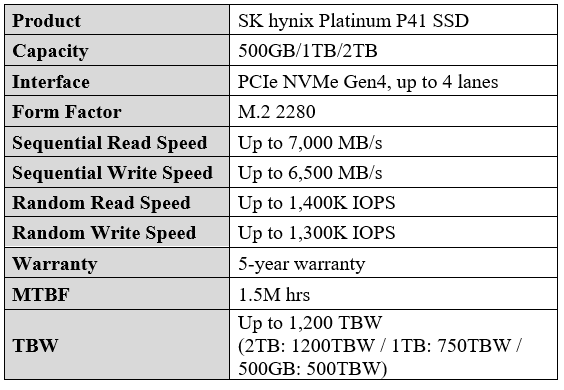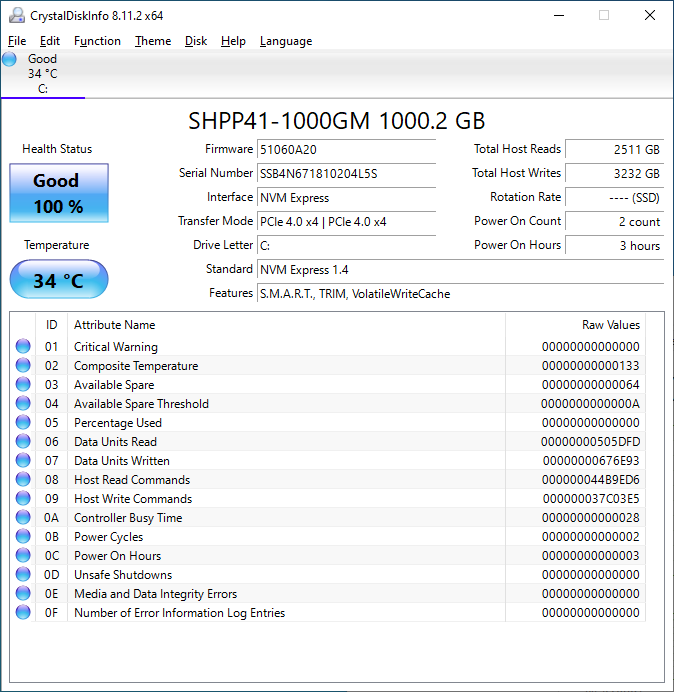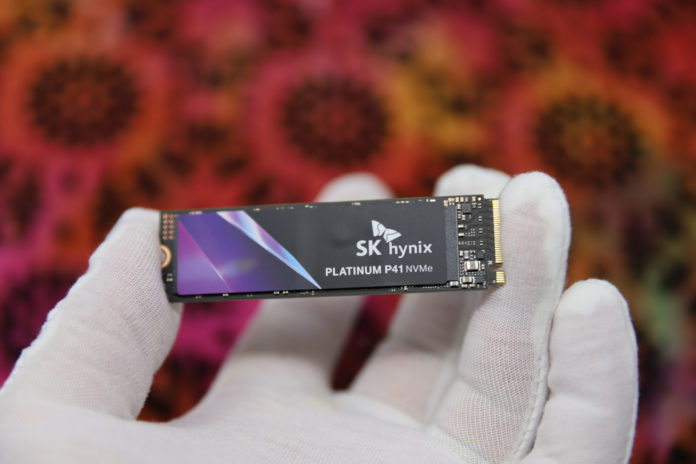Today we are taking a look at the SK hynix Platinum P41 1TB NVMe SSD. The Platinum P41 is the PCIe 4.0 successor to the Gold P31, which for me has long been the standard-bearer for PCIe 3.0 drives. That gives the P41 some big shoes to fill, and competition is already tight at the high-end for PCIe 4.0 drives, so we will see how the P41 manages to stack up.
SK hynix Platinum P41 1TB NVMe SSD
The SK hynix Platinum P41 1TB comes in a single-sided M.2 2280 (80mm) form factor. Most other PCIe 4.0 SSDs come with the option of a heatsink, while the P41 does not. Keep that in mind when we get around to thermal testing.

The SK hynix Platinum P41 bundles 176-layer TLC NAND with SK hynix’s new “Aries” controller. Unlike the P31, the controller on the P41 appears to be a 8-channel design, which matches most other high-end SSD controllers. Also included is a DDR4 DRAM cache, with the 1TB drive featuring 1GB of cache.

The rear side of the drive has nothing except some silkscreened logos and regulatory markings.
SK hynix Platinum P41 SSD Specs
The SK hynix Platinum P41 line of SSDs is available in sizes between 500GB and 2TB.

Today we are looking at the 1TB model, which is rated at 7000 MB/s sequential read and 6500 MB/s sequential write. These specs target the P41 squarely at the highest end PCIe 4.0 drives, so expectations will be high when it comes time to benchmark. Rated endurance for the 1TB drive is 750 TBW, which ties the P31 and is above average for most of the 1TB SSDs that I review. Lastly, the drive comes with a standard 5-year warranty which is the preferred length of warranty for a premium drive.

CrystalDiskInfo can give us some basic information about the SSD and confirms we are operating at PCIe 4.0 x4 speeds using NVMe 1.4.
Test System Configuration
We are using the following configuration for this test:
- Motherboard: ASUS PRIME X570-P
- CPU: AMD Ryzen 9 5900X (12C/24T)
- RAM: 2x 16GB DDR4-3200 UDIMMs
Our testing uses the SK hynix Platinum P41 1TB as the boot drive for the system, installed in the M.2_1 slot on the motherboard. The drive is filled to 85% capacity with data and then some is deleted, leaving around 60% used space on the volume.
Next, we are going to get into our performance testing.





test power and efficiency otherwise useless review
I don’t care about power on a SSD
If after running all the tests one starts over with the first one, are they repeatable?
The housekeeping and wear leveling chores could change over time even on a freshly trimmed drive. While I know each test includes multiple trials within each run, going through the whole benchmark series three (or more) times and breaking out the maximum, median and minimum results in a separate graph would add some statistics to the review which I’d find meaningful.
This is truly a pointless review if energy efficiency isn’t measured. That is what SK Hynix SSDs are famous for. No one cares if it gets hot under extreme load. Laptops usually have heatsinks to help with heat anyway.
May I ask why is Samsung 980 PRO drive missing from the comparison lineup? Given samsungs historical primacy as performace leader in segment, I would expect it to be THE benchmark for others to compare against.
I have the P31 Gold 1TB drive. It’s a good drive overall and my complaints about it are centered around the lack of firmware updates and the overall usefulness of their drive tools (something Intel and Samsung are great at). The drive tools are plain ugly due to poor formatting causing overlapping text and numbers. There hasn’t been a new firmware release since I bought the drive early last year. Aside from that it’s been a great drive. I’d pick up a P41 once I build a computer that has PCIe 4.0 support. Hopefully they’ve polished up the drive tools and support the drive with firmware (if needed)
Secondary question – does anyone know why are SK hynix consumer ssd seemingly absent from european market?
There some ram modules, but ssd are not listed seemingly anywhere ( Czech Republic region).
The phison E16 gen had around 1400 TBW for a 1 TB SSD. now that has come down to 750 TBW. Any idea Why that is
May I ask you a question why do Samsung drives are missing on the graphs? They are quite a good ones and I’ve used’em for years. Would be a good comparison point
Artem – that is a fairly easy one. We tested many of the Samsung drives when we were still using 500-512GB drives. We swapped to 1TB and folks do not like seeing 512GB drives with 1TB given performance variations at capacity points.
Just so you know, we have a few Samsung and Sabrent drives (Sabrent was also in this with either larger or smaller than 1TB drives) coming so we can add them.
As SSDs evolve in their underlying flash memory structure (SLC -> QLC), it would be interesting if you could say more about the used SSD controller properties. Especially with non-consumer SSDs the properties of the controller may have a large impact on the life expectancy and durability of the SSD. I’m thinking for example of wear levelling: dynamic wear levelling versus static (& global) wear levelling. With Project Kenko 01 you you took a look at the wear and tear in a quantative way. That will usually not be possible for reviewing & testing new SSDs. However, considering your expertise, it should be possible to say something in a qualitative way about the controller, either extracted from the datasheets or via personal connections within the industry.